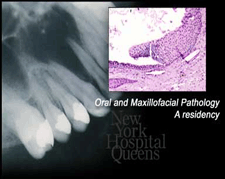المقالات
Denture Hyperplasia

Denture hyperplasia is characterized by a smooth, tumor-like mass that forms within the space between the cheek and the gums (the vestibular sulcus) in response to chronic irritation caused by the flange of a poorly-fitting denture. It also occurs in the lower jaw between the inside surface of the gums and the floor of the mouth. It is most common in those with immediate dentures, or in those who have worn the same denture (complete or partial) for many years. With time, dentures become loose or ill-fitting due to bone loss and shrinkage of the gums. This in turn causes the denture borders to rub excessively into the vestibular sulcus or floor of the mouth. This causes irritation and increased thickness in these tissues, resulting in denture hyperplasia.
Initially the mass is soft and smooth, but becomes grooved, knob-like and firm as it enlarges. The grooves on the mass can become ulcerated and swollen, causing the mass to be quite painful. A condition called papillary hyperplasia, another condition that can affect long-term denture wearers and that is characterized by multiple small, merging, pimple-like lesions on the soft palate, can accompany denture hyperplasia. Denture hyperplasia occurs most often in individuals of either sex who are over 40 years of age. Without treatment, the condition will persist and will increase in size and degree of ulceration; this lends itself to infection.
Removing the source of the infection typically results in the bone returning to its normal density. We can accomplish this by:
* Carefully excising - or surgically removing - the entire growth.
* Creating a new denture that fits properly so the problem does not recur.
* Re-lining your existing dentures to correct the fit is another option that may be available to you. The most important thing to learn from this condition is that dentures are not permanent restorations. They require periodic re-lining, rebasing, or complete replacement to ensure a proper fit as your jaw bone and soft tissues change over time.
